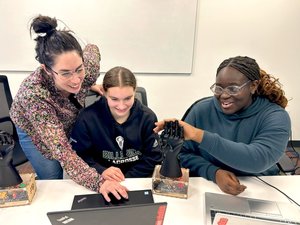
Not a year goes by that MIT isn't churning out awe-inducing innovations. We're aware. In that sense, the past 12 months haven't been special. But that doesn't make the research, development and general initiatives that went down at the Institute over 2016 any less impressive.
We culled the long list of innovations coming out of the Kendall Square school this year to find some of the coolest ones. So in case you haven't been paying attention, here's what you've missed from MIT.
In October, MIT invited members of the community to 501 Mass. Ave. to reveal its latest efforts in entrepreneurship: The Engine. What is it? A new accelerator program, as well as a planned $150 million venture fund run by the university. These resources are to be used to support startups innovating in the science and technology spaces.
Turning greenhouse gases into gasoline
The modern day equivalent to turning water into wine (only far more scientific), MIT researchers have brought us closer to turning carbon emissions into gasoline. The group of chemists made a new catalyst material that would convert carbon dioxide into carbon monoxide - a crucial, initial step toward converting CO2 to other chemicals, including fuels.
At MIT’s 2016 Open House, visitors were in for a treat: They were able to take rides on an autonomous mobility scooter. The rides were used to test software made by researchers from MIT, the National University of Singapore and the Singapore-MIT Alliance for Research and Technology (SMART). Before these scooter trials, the researchers had tested the same sensor configuration and software testing on autonomous cars and golf carts.
Popeye may have made it seem like spinach was only for strength, but MIT proved it could also be used to detect explosives. Engineers at the Institute embedded spinach plant leaves with carbon nanotubes, and the leafy greens were able to wirelessly transmit information on potential explosives to handheld devices.
You read that correctly: MIT was the home of a Puppy Lab this past year. Stephanie Ku, a graduate student in the Harvard-MIT Program in Health Sciences and Technology, started the lab to test whether animal interaction could relieve stress among members of the MIT community. She received a grant from the MindHandHeart Innovation Fund and opened a regular space on campus where people could come to pet and play with dogs.
A way to take pictures of black holes
In June, folks at MIT's Computer Science and Artificial Intelligence Laboratory, the Harvard-Smithsonian Center for Astrophysics and the MIT Haystack Observatory announced they've come up with a new method that could let astronomers take the first-ever image of a black hole. The group of researchers developed a new algorithm that would piece together data collected from radio telescopes around the world. This method would basically turn all of Earth into one, big radio telescope and allow scientists to assemble an image of a black hole.
In February, almost 100 years ago today, Albert Einstein predicted gravitational waves about 100 years ago. And this year, scientists in the LIGO Scientific Collaboration, in which with researchers at MIT and Caltech have a major hand, directly detected the ripples of gravitational waves caused by a collision of two black holes 1.3 billion light years away from Earth. Their observation serves as significant confirmation of Einstein’s theory of general relativity.








